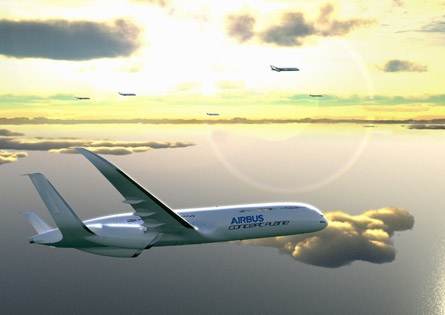Fully optimising air traffic management and aircraft systems would cut 13min from the duration of the average flight in Europe and the USA, saving nine million tonnes of excess fuel and cutting 28 million tonnes of CO² emissions each year.
New research from Airbus suggests the dramatic reductions in flight times and CO² emissions are already possible, but with further improvements in aircraft design and the development of alternative energy sources, even larger performance gains would be achievable.
The airframer has released the latest iteration of its publication - The Future By Airbus - describing it as "a vision for sustainable aviation in 2050 and beyond".
Airbus says that for the first time, its publication looks beyond aircraft design to potential performance gains from operational improvements, whether the aircraft is on the ground or in the air.
 |
|---|
|
Airbus |
Charles Champion, Airbus executive vice-president engineering, says: "Our engineers are continuously encouraged to think widely and come up with 'disruptive' ideas which will assist our industry in meeting the 2050 targets we have signed up to.
"These and the other tough environmental targets will only be met by a combination of investment in smarter aircraft design and optimising the environment in which the aircraft operates. That is why our latest Future By Airbus concepts focus on not just what we fly, but how we may fly in 2050 and beyond."
Its vision, dubbed "Smarter Skies", encompasses five concepts which could be implemented across all stages of an aircraft's operation.
These include take-offs in a continuous "eco-climb" which would utilise renewable power to assist take-offs, allowing steeper climbs from airports, cutting noise and potentially reducing the amount of land required for runways.
Another concept is the creation of "express skyways", where aircraft could fly in formation to cut drag on high-frequency routes. Aircraft would also be able to select the most efficient route for the journey to make "the optimum use of prevailing weather and atmospheric conditions".
Landings could be improved by allowing free-glide approaches without the need to run an aircraft's engines.
Once on the ground, "autonomous, renewably powered taxiing" would allow aircraft to be cleared from runways faster to optimise terminal space and remove runway and gate limitations.
Lastly, the increased use of renewable energy sources at airports would "further reduce aviation's environmental footprint".
"We know people want to fly more in the future and our forecasts support this. We also know that they don't want to fly at any cost," says Champion.
"Our focus at Airbus is on meeting this continuous growth in demand, keeping the passenger, our customers and the environment at the centre of our thinking."
Source: Flight International




















